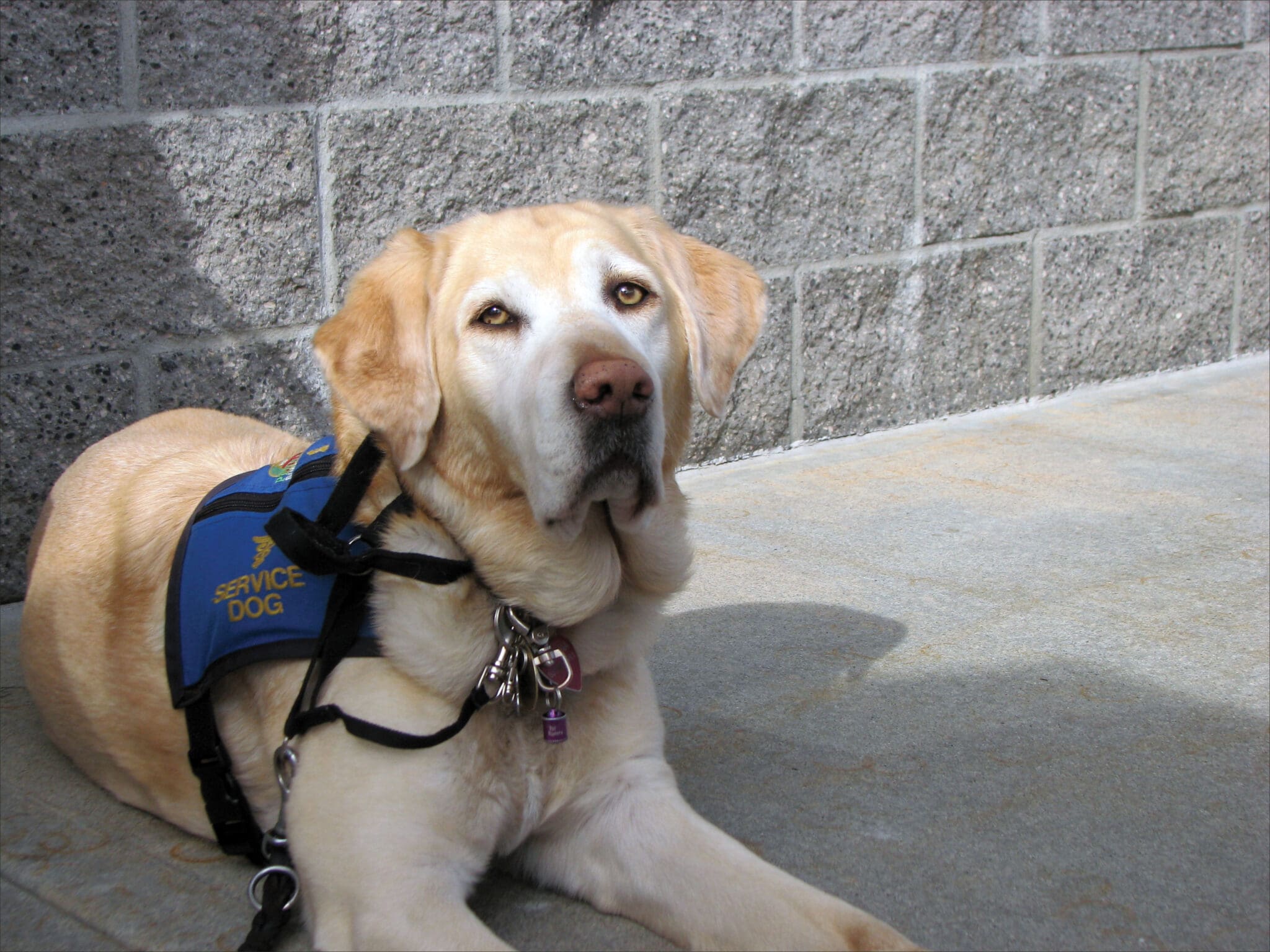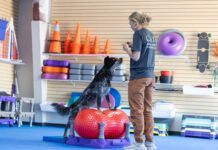Service dogs for people with diabetes are the “tattletales” of the dog world, according to Rita Martinez, co-author of a new book, Training Your Diabetic Alert Dog. The job for these special dogs is to notice a change in a person’s blood glucose level, and then tell that person about it. If that person doesn’t “listen” to the dog or isn’t able to respond, then a diabetic alert dog may tell someone else!

288
No one knows this better than Sisi Belcher, whose dog Nicolina has sounded the alarm on more than a few occasions. Perhaps the most dramatic happened one time when Belcher was at work.
Nicolina had accompanied Belcher to her office, which was at the police department on a university campus. Keeping blood glucose in the proper range is a constant challenge for someone with Type 1 diabetes. If Belcher failed to respond to an alert or was having a problem, Nicolina had been known to go to Belcher’s coworkers for help. On this particular day, however, Belcher was alone in the office when her blood glucose crashed. Nicolina likely looked for help from the usual coworkers, but when she couldn’t find anyone, this resourceful dog took matters into her own paws.
Nicolina traveled down the hallway of the building and ended up at a break room where a group of police officers were hanging out. The officers quickly assessed the situation: What was Nicolina doing there alone? Where was Belcher? They went to investigate, knowing something must be wrong. The police officers found Belcher unable to respond, but, thanks to Nicolina’s efforts, they were able to call for medical assistance and Belcher received the help she needed.
Only Nicolina knows exactly what went through her mind that particular day, but it is evident that this diabetic alert dog was creative and resourceful, and took her job as a tattletale dog very seriously.
A DOG ON THE JOB
Fortunately, and in most cases, a diabetic alert dog (also called a DAD) can alert the person before outside medical intervention is needed. In fact, one of the advantages of living with a DAD is that they can often detect changes in blood glucose well before it registers on a blood glucose meter or continuous glucose monitor.
Martinez says that over the years, the experiences of people who are paired with a DAD show that dogs generally detect and alert to raises or drops in blood glucose 15 to 30 minutes before the changes show up on a meter.
“That means [people with diabetes] can act on correcting their blood glucose level sooner, before it gets as far out of range,” says Martinez. Treating glucose fluctuations sooner means better disease control and may help protect against the eye, brain, and kidney damage that is so often caused by diabetes. Most people who live with a DAD have improved management of their disease.
Dogs cannot replace the other interventions and support a person with diabetes must use, but a DAD does offer another option. Belcher notes that Nicolina has alerted her many times before the meter registered changes. As Belcher watches her dog, she says, “Just look at her nose. It is always going.”
ALL ABOUT THE NOSE
Just how can a DAD beat out a glucose meter? Scientists are not entirely sure why, but when a person’s blood glucose changes, it creates a specific scent or odor. This scent surrounds the person and is found in breath, saliva, and sweat. The change in scent is easily detected by a dog’s amazing sense of smell, and with more than 220 million scent receptors (as opposed to the mere 5 million that people have) recognizing odor is a natural job for a dog. A diabetic alert dog, however, does more than just recognize the odor. A DAD is trained to provide a clear sign, called an alert, whenever the odor is present. He can show if glucose is high or low, and most DADs are also trained to go find help if the person does not respond.
The protocol that Martinez uses and describes in Training Your Diabetic Alert Dog begins by teaching the dog the alert first, before any scent work is added into the training. Using clicker training methods, each dog is taught a specific initial alert behavior (often a nose nudge for larger dogs or a soft pawing action for smaller dogs). Each dog is also taught two additional signals: one for high glucose and one for low glucose.
For example, a dog may nose-nudge the person’s leg to indicate there is a scent change. This is the initial alert signal. Then the person being alerted can present a flat hand and the dog may nudge the hand upward for high glucose and downward for low glucose. Martinez recommends that the dog’s handler choose alert and signal behaviors that a dog can easily do anywhere, at any time.
Once the alert and high and low signals are completely reliable and on a verbal cue, only then does the scent work begin. To teach the dog how to recognize the odor, a sample of saliva can be taken during a high or low glucose period. The samples can be kept in a freezer and brought out for training sessions. To start off, the dog is presented with the sample, and is rewarded when he recognizes the scent. Martinez calls this the imprinting step and says that dogs will generally learn to recognize the scent very quickly, over a few short sessions.
Once the dog knows the alert behavior and has imprinted on the scent, then he is trained using an alert chain. The alert chain in training may look like:
Dog recognizes the scent; the person gives a verbal cue for the alert behavior; the dog performs the alert behavior; the person clicks and treats.
Quickly, the dog will begin to pair the scent as the cue for the alert behavior. The scent becomes the environmental cue for that behavior. The chain, once established, will transform to:
Dog recognizes the scent; the dog offers the alert without being asked; the person then clicks and treats.
Training, of course, does not stop here. DADs need to learn to offer the alert spontaneously, not just when they are “playing the game” and training cues are present. The high and low signals can be added to the chain. The dogs must learn to do the alert and signals in a variety of situations, such as in public and in a car. They must learn that alerting is important even when they are playing. They must learn to wake up and alert at night.
There are many steps to training a DAD to understand that giving the alert reliably and in every situation is what will earn them a reward. Martinez emphasizes that it is a labor-intensive process, and you need to take your time in order to have a dog who both loves his job and does it consistently and accurately.
DOG’S REWARD?
For the person, having a dog to help with disease management is an obvious reward. And, for the dog lover, getting to spend 24/7 with his or her dog is an added bonus.
But what about the dog? Being a DAD is hard work. DADs must be aware all of the time. They must sometimes leave something they are enjoying to offer an alert.
Like any dog, the reward is a critical part of the job. In order for a DAD to be reliable, the “paycheck” must be very valuable and it must be given generously. For Nicolina, that paycheck comes in the form of a hot dog.
“She will do anything for a hot dog,” says Belcher.
But the paycheck is only one piece of what drives a DAD to do the job. Belcher and Martinez agree that the bond that forms between the handler and the dog is also part of the motivation puzzle. Both person and dog benefit from this tight relationship, and like any good relationship, it just grows stronger over time. But there is another piece that really makes this a special kind of work for a dog.
“These dogs love their job, they are thrilled they are able to do it,” said Martinez. “A dog using his nose is one of the most natural things there is. For them to be able to do it, and have fun, and make someone happy – well, there is nothing better.” But Martinez also emphasizes that this is not a job every dog will take to and you cannot force a dog to perform it.
“He has to want to do it,” says Martinez. All dogs have the nose to be alert dogs, but for a really reliable DAD, the dog must also want to do it and enjoy doing it. Much the way a herder loves to move sheep, a DAD must love to recognize odor and play the alert game.
DIFFERENT FROM OTHER SCENTING DOGS
DADs and other medical alert dogs are recognizing scent, but they do so in a much different way than your typical search and rescue dog, law enforcement dog, or even a dog who enjoys the sport of nose work.
Searching for a missing person, a cadaver, drugs, or the birch oil used in the sport of nose work all involve the handler giving a cue first, and the dog searching for the scent second. Dogs that search know when they are on duty, and have plenty of time in their life when they are not on duty.
A DAD must be on the lookout for the scent at all times. The DAD must take initiative and announce (tattle) when the scent is present. They don’t have the benefit of the handler saying: There is something for you to find here. Go look.
Another thing a DAD must do is to keep pushing, even if you dismiss or do not listen. They are trained to continue alerting until someone listens (and they are given their reward).
THE LIFE-SKILLS OF A GREAT DAD
The enthusiasm that makes for a great DAD is something that can be encouraged, but the dog has to possess the right personality traits to start with. Martinez says that the type of dog who does well as a DAD is alert enough to recognize the scent and act on it independently, without any prompts.
Like all service animals, a DAD who is certified for public access must also have a comfort level with odd situations and be secure enough not to need to investigate new places, people, or animals.
A DAD has to be a dog who naturally walks that fine line between too much enthusiasm (some would call it drive) and not enough enthusiasm. A good DAD candidate is a thinking dog who feels confident when she needs to take initiative, but does so in a calm manner.
Nicolina, by all casual appearances, is a typical low-key yellow Lab. She kicks back, resting quietly at a coffee house. She can hang out with Belcher at work all day. She is comfortable with other animals and loves children. She travels through airports and is not fazed by the screening or security. But once she is on the scent, she becomes insistent and determined. And that balance of persistence and calm is what makes a DAD do her job well.
For example, when Nicolina smells or detects a change in Belcher’s scent, she will sit in front of Belcher and stare intently. This is her first alert. If Belcher does not respond, Nicolina ups the ante to a nudge. If Belcher still does not respond, Nicolina will bark at her, and if there is still no response, Nicolina will calmly find Belcher’s husband, coworker, or another helper.
FINDING A DAD
A DAD can be any type of dog, as long as he has the right personality for the job. A calm, friendly terrier or a Lab with enthusiasm will both enjoy the job of a DAD. You can start with a puppy but a well-socialized rescue dog with the right personality can be just as good a candidate. You can train a dog yourself, with the help of a qualified service dog trainer. Or you can choose to find a dog through a service dog program.
Getting a dog from a service dog program is a good option for some people. The program trains the dog first, and then trains you how to live with the dog. The advantages are that you get dogs that have a proven record of enjoying the job and that have been public access certified. The disadvantages are that there is often a long waiting list, there may be some restrictions regarding the placement of the dog, and the organization may retain ownership of the dog. Some organizations provide DADs free to a qualified person; but others charge a lot of money for a trained dog.
Whether you want to get a dog from an organization or train one yourself with the help of a qualified service dog trainer, always do your due diligence. Check out the trainer or the organization carefully. Ask how long they have been doing it, look into their reputation (not just what they say on their website), and check references.
The advantages of working privately with a trainer include that you will have the opportunity to bond during the socialization and training phase, and you will learn from the process how to keep your dog’s skills up. And a reputable service dog trainer will have the same stringent requirements and certification for public access that an organization should possess.

288
The disadvantage is that you won’t have confirmation of your puppy or adult dog’s aptitude until about four months into the process; will the dog you have really want to do this job? Martinez says that it can be difficult to find just the right dog, one who wants to do the job, but is also naturally relaxed. If your dog does not pass the “want to” test, or for some other reason is not the right dog for the job, will you be able, emotionally, to place her in a good home and start again?
Either way, getting a dog via a service organization or working with a private trainer to train your own dog, you will need to continue the foundation training throughout your dog’s life. Belcher says that she and Nicolina practice the public access behaviors and alert behaviors every day, and they get recertified once a year.
LIVING WITH A DAD
Martinez says that living with a service dog is not for everyone. The DAD will become someone who accompanies you everywhere. They are not tools or servants, but life partners. They will also become someone whose needs are equal to your own as you go through your day.
Living with a DAD will take your time and energy and add another expense. Your entire family will be impacted. If you have other pets in the house, they will also be affected.
One of the most important requirements for living with a DAD is meeting his need to be a dog and engage in dog activities. For example, Belcher works hard to make sure that Nicolina has plenty of opportunity to enjoy life. Nicolina, says Belcher, is a fun-loving and social dog. She enjoys greeting people, playing with her Wubba Wubba toy, chasing a Frisbee, and long walks.
Living with a DAD, Belcher says, will change your life dramatically. If you love dogs, the walking and playing will be enjoyable. For a person living with a DAD, the public access requirement may bring the biggest rewards and also some of the biggest challenges, says Belcher. You will become a walking billboard that says: I have a medical problem.
“Nicolina draws a lot of attention,” says Belcher. “You have to be very patient with people.” Belcher says when you live with a DAD, you have to be comfortable with strangers knowing there is a reason you need a service dog and asking questions about your medical condition and about your dog.
Belcher says she sometimes feels like a public educator. She also acknowledges that there are rare times when she just doesn’t want to talk with or educate strangers. But she’s also had some wonderful conversations from interactions that some might consider an intrusion. She’s been able to let other diabetics know about DADs as partners, and about some of the medical studies and treatments that she’s participated in.
Martinez says that it is also not uncommon for a person who has a service dog to be discriminated against. It is illegal to prevent access to people with service dogs, but not all business owners and landlords know this. It is sometimes necessary for a person to insist on her right to public access. Being assertive and comfortable speaking up is helpful if you live with any type of service dog.
Martinez emphasizes that it is very important to respect a person’s right to have a dog to aid him or her with a disability. And, while most people who approach to talk with the person or pet the dog mean well, it is still an intrusion. It is important to be sensitive and not distract service dogs.
FIRST AND FOREMOST, DADS ARE DOGS
Martinez and Belcher both emphasize that having a dog will not fix your diabetes, or make you better. Dogs are not perfect. They make mistakes or may miss a signal. Belcher is quick to point out that people also make mistakes and that the equipment used for checking and monitoring glucose is not perfect either.
It is about the teamwork. Belcher says, “I have my medical interventions, I have my husband, and I have my dog.” A DAD is one part of the support team that can help a person with diabetes stay healthier. It is also a job that is naturally suited for some of our canine friends.
Special thanks to Rita Martinez and Sisi Belcher for their contributions to this article.
Mardi Richmond, MA, CPDT-KA is a writer and trainer who is having a lot of fun learning about all types of scent work! She lives in Santa Cruz, California with her partner and a heeler-mix named Chance.





